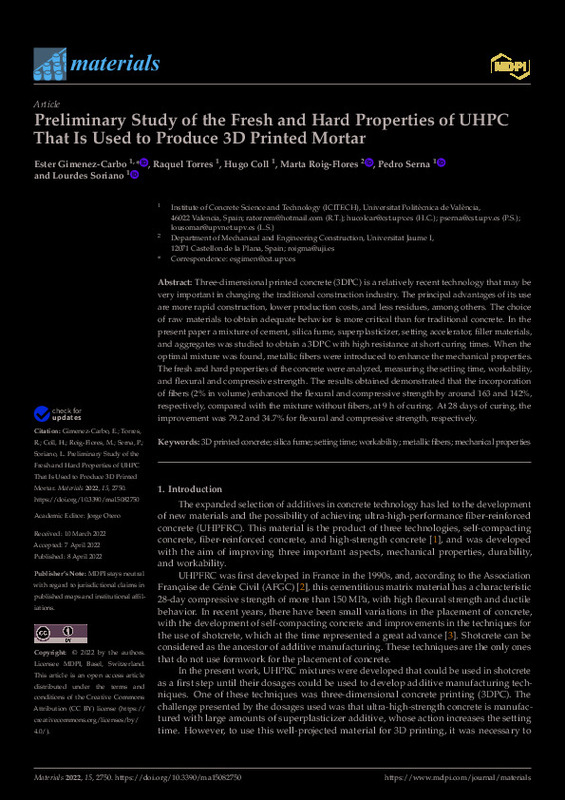JavaScript is disabled for your browser. Some features of this site may not work without it.
Buscar en RiuNet
Listar
Mi cuenta
Estadísticas
Ayuda RiuNet
Admin. UPV
Preliminary Study of the Fresh and Hard Properties of UHPC That Is Used to Produce 3D Printed Mortar
Mostrar el registro sencillo del ítem
Ficheros en el ítem
| dc.contributor.author | Gimenez-Carbo, Ester
|
es_ES |
| dc.contributor.author | Torres, Raquel
|
es_ES |
| dc.contributor.author | Coll Carrillo, Hugo
|
es_ES |
| dc.contributor.author | Roig-Flores, Marta
|
es_ES |
| dc.contributor.author | Serna Ros, Pedro
|
es_ES |
| dc.contributor.author | Soriano Martinez, Lourdes
|
es_ES |
| dc.date.accessioned | 2023-02-13T19:00:37Z | |
| dc.date.available | 2023-02-13T19:00:37Z | |
| dc.date.issued | 2022-04 | es_ES |
| dc.identifier.uri | http://hdl.handle.net/10251/191802 | |
| dc.description.abstract | [EN] Three-dimensional printed concrete (3DPC) is a relatively recent technology that may be very important in changing the traditional construction industry. The principal advantages of its use are more rapid construction, lower production costs, and less residues, among others. The choice of raw materials to obtain adequate behavior is more critical than for traditional concrete. In the present paper a mixture of cement, silica fume, superplasticizer, setting accelerator, filler materials, and aggregates was studied to obtain a 3DPC with high resistance at short curing times. When the optimal mixture was found, metallic fibers were introduced to enhance the mechanical properties. The fresh and hard properties of the concrete were analyzed, measuring the setting time, workability, and flexural and compressive strength. The results obtained demonstrated that the incorporation of fibers (2% in volume) enhanced the flexural and compressive strength by around 163 and 142%, respectively, compared with the mixture without fibers, at 9 h of curing. At 28 days of curing, the improvement was 79.2 and 34.7% for flexural and compressive strength, respectively. | es_ES |
| dc.language | Inglés | es_ES |
| dc.publisher | MDPI AG | es_ES |
| dc.relation.ispartof | Materials | es_ES |
| dc.rights | Reconocimiento (by) | es_ES |
| dc.subject | 3D printed concrete | es_ES |
| dc.subject | Silica fume | es_ES |
| dc.subject | Setting time | es_ES |
| dc.subject | Workability | es_ES |
| dc.subject | Metallic fibers | es_ES |
| dc.subject | Mechanical properties | es_ES |
| dc.subject.classification | INGENIERIA DE LA CONSTRUCCION | es_ES |
| dc.title | Preliminary Study of the Fresh and Hard Properties of UHPC That Is Used to Produce 3D Printed Mortar | es_ES |
| dc.type | Artículo | es_ES |
| dc.identifier.doi | 10.3390/ma15082750 | es_ES |
| dc.rights.accessRights | Abierto | es_ES |
| dc.contributor.affiliation | Universitat Politècnica de València. Escuela Técnica Superior de Ingenieros de Caminos, Canales y Puertos - Escola Tècnica Superior d'Enginyers de Camins, Canals i Ports | es_ES |
| dc.description.bibliographicCitation | Gimenez-Carbo, E.; Torres, R.; Coll Carrillo, H.; Roig-Flores, M.; Serna Ros, P.; Soriano Martinez, L. (2022). Preliminary Study of the Fresh and Hard Properties of UHPC That Is Used to Produce 3D Printed Mortar. Materials. 15(8):1-11. https://doi.org/10.3390/ma15082750 | es_ES |
| dc.description.accrualMethod | S | es_ES |
| dc.relation.publisherversion | https://doi.org/10.3390/ma15082750 | es_ES |
| dc.description.upvformatpinicio | 1 | es_ES |
| dc.description.upvformatpfin | 11 | es_ES |
| dc.type.version | info:eu-repo/semantics/publishedVersion | es_ES |
| dc.description.volume | 15 | es_ES |
| dc.description.issue | 8 | es_ES |
| dc.identifier.eissn | 1996-1944 | es_ES |
| dc.identifier.pmid | 35454441 | es_ES |
| dc.identifier.pmcid | PMC9027915 | es_ES |
| dc.relation.pasarela | S\465026 | es_ES |
| dc.contributor.funder | Universitat Politècnica de València | es_ES |
| dc.subject.ods | 12.- Garantizar las pautas de consumo y de producción sostenibles | es_ES |
| upv.costeAPC | 2420 | es_ES |








